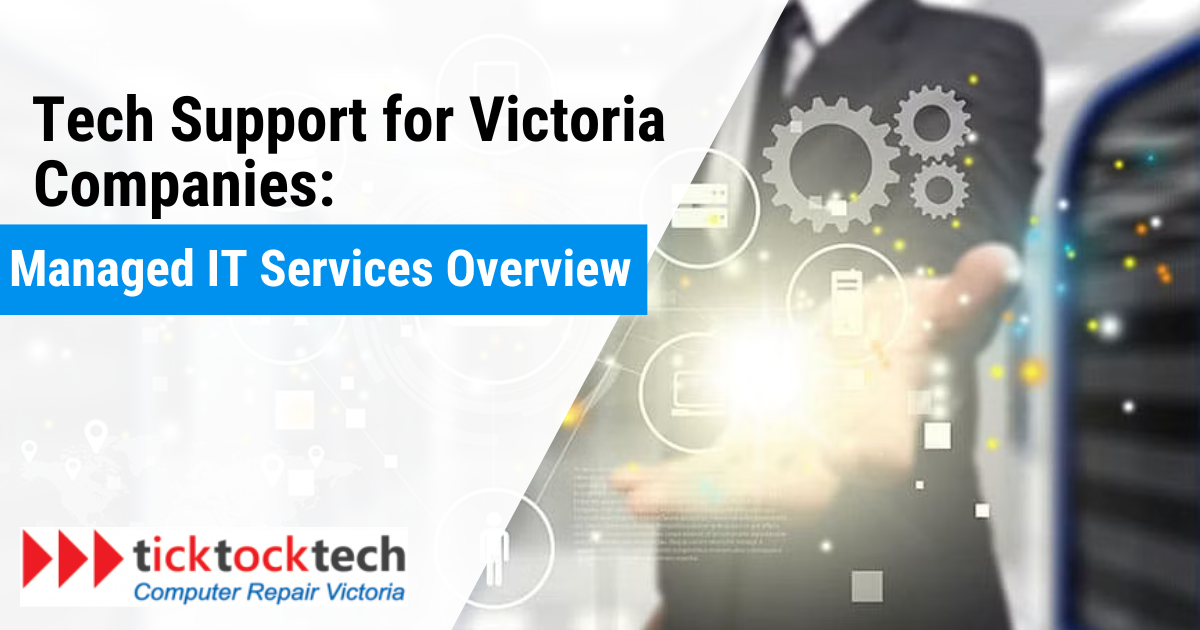Technology is at the core of business operations in today’s rapidly evolving digital landscape, playing a pivotal role in the operations, growth, and success of Victoria Victoria Companies of all sizes. Businesses, from small startups to multinational corporations, depend on various IT systems and infrastructure to maintain their competitive edge, streamline processes, and drive growth. However, managing and maintaining these technologies can take time and effort.
However, managing and maintaining IT infrastructure can be complex and resource-intensive, especially for smaller and mid-sized businesses. It is where managed IT services come into play, offering a comprehensive solution to ensure the smooth functioning of IT environments while allowing organizations to focus on their core business activities. In this article, we will delve into the world of managed IT services, exploring what they are, their benefits, and how they can be tailored to suit the unique needs of different Victoria Companies.
What are managed IT services?
Managed IT services, or Managed Service Providers (MSPs), are specialized IT support that leverages a proactive approach to technology management and maintenance. These services encompass many IT-related functions, from basic tasks like network monitoring and software updates to complex activities such as data security, disaster recovery planning, and technology consulting.
Instead of relying on reactive IT support, where issues are addressed after they occur, managed IT services work to prevent problems from arising in the first place. This proactive model can help Victoria Companies maintain a stable and efficient IT environment while reducing downtime and costly disruptions. They aim to identify and resolve potential problems before they impact the business, thus minimizing downtime and maintaining the reliability and efficiency of the IT environment.
Critical Components of Managed IT Services
Managed IT services encompass various support offerings to meet a company’s needs. Some of the core components include

1. Remote Monitoring and Management (RMM)
Managed IT service providers use advanced monitoring tools to constantly monitor a company’s IT infrastructure. It allows them to detect and resolve issues before they become significant problems.
2. 24/7 Helpdesk support and monitoring
Managed IT services often provide around-the-clock technical support by continuously monitoring the company’s IT infrastructure, which includes servers, networks, and endpoints, to identify potential issues, vulnerabilities, or security threats. It ensures that Victoria Companies can get assistance, even during weekends or holidays.
3. Security services
Security is a paramount concern for modern businesses. Managed IT service providers offer antivirus, firewall management, and threat detection services to safeguard a company’s data and systems.
4. Data backup and disaster recovery
Data is one of the most critical assets for Victoria BC Companies. Managed IT services typically include automateddata backup and recovery solutions to ensure that data is protected and easily recoverable in case of unexpected disasters or data loss.
5. Cloud services
As more Victoria BC Companies migrate to the cloud, managed IT services often include support for cloud-based applications, data storage, and infrastructure management. It is done to improve accessibility, scalability, and cost-efficiency.
6. IT strategy and planning
Managed IT services providers work closely with businesses to develop long-term IT strategies that align with their goals and objectives. It includes technology roadmaps and budget planning.
7. Regular updates and patch management
Managed IT service providers ensure that software, operating systems, and applications are consistently updated and patched to protect against security vulnerabilities and exploits.
8. Vendor and network management
They also handle vendor relationships, ensuring that a company’s hardware and software providers are responsive and accountable. This component includes network optimization, bandwidth management, and the maintenance of network hardware.
Benefits of Managed IT Services for Companies
1. Cost savings: Managed IT services can significantly save businesses by preventing costly downtime and reducing the need for in-house IT staff. The costs are predictable and often lower than hiring in-house IT staff and managing IT infrastructure independently.
2. Efficiency and increased productivity: With proactive monitoring and issue resolution, employees can focus on tasks without technical problems interrupting them. Also, with reliable IT systems and minimal downtime, employees can work more efficiently and productively, contributing to business success.
3. Enhanced security: Managed IT Services focus on safety, implementing the latest tools and strategies to protect against cyber threats. It is imperative in an era when cybersecurity is a top concern for businesses of all sizes.

4. Strategic planning: Managed IT services providers help companies align their technology with business objectives, fostering growth and innovation.
5. Compliance and regulations: Compliance with industry-specific regulations is crucial for some businesses. Managed IT Services providers stay current with industry regulations and compliance requirements, ensuring your business meets legal obligations.
6. Expertise and Skills: MSPs employ experts with a wide range of skills and knowledge. Companies benefit from their collective expertise without the need for extensive in-house training.
Tailoring Managed IT Services to Company Needs
Not all businesses have the same IT needs. Smaller companies may require more basic IT support, while larger enterprises might have complex and extensive IT environments. Managed IT Services are highly flexible and can be tailored to meet each organization’s requirements. Here’s how this customization works:
- Assessment and needs analysis: The first step is to evaluate a company’s current IT infrastructure and future needs. It involves understanding the existing systems, identifying pain points, and establishing goals for improvement.
- Customized service plans: Based on the assessment, a Managed IT Services provider will create a service plan that aligns with the company’s needs, budget, and goals. It may include selecting specific components and services from the provider’s offerings.
- Service Level Agreements (SLAs): Companies and their MSPs will define SLAs, which outline the responsibilities, performance metrics, and expectations of both parties. This agreement ensures transparency and accountability.
- Continuous review and adjustment: Managed IT Services can be adjusted accordingly as a company’s IT needs evolve. This ongoing review ensures that the services align with the company’s objectives.
Choosing the Right Managed IT Services Provider
Selecting the right managed IT services provider is crucial for any company. Here are some key factors to consider:
1. Reputation and experience: Look for providers with a solid track record and experience in your industry. Check their references and read reviews from other clients.
2. Service Level Agreements (SLAs): Clearly define SLA expectations and responsibilities. This document will be essential for managing the relationship. Ensure the SLAs align with your business needs, including response times and issue resolution expectations.
3. Scalability: Ensure the provider can accommodate your growth and evolving technology requirements. Your IT needs may change, and you want a partner who can adapt their services accordingly.
4. Security protocols: Inquire about the provider’s security practices and compliance with industry standards. Data breaches can have severe consequences, so it’s essential to prioritize security.
5. Pricing Structure: Understand the cost structure and ensure it fits your budget.
6. Cost and Transparency: Understand the pricing structure and ensure no hidden costs. Transparency in pricing and billing is essential.
7. Client Support and Communication: Effective communication is vital. Ensure the provider has a dedicated support team and a transparent communication process.
8. Service Offerings: Ensure that the provider offers the specific services you need and that they can customize their offerings to match your requirements.
9. Response Times: A fast response to IT issues is crucial. Ask about the provider’s response times and procedures for handling urgent problems.
Conclusion
Managed IT Services are an invaluable resource for businesses of all sizes, helping them navigate the increasingly complex world of technology. By outsourcing IT management and support to experts, companies can streamline their operations, enhance security. Also, they focus on their core business objectives. With customization options and a wealth of benefits, managed IT services have become essential to modern business success.
When selecting a provider, it’s necessary to evaluate your specific needs, review their offerings, and consider factors such as reputation, security, and scalability. In the ever-evolving technology landscape, Managed IT Services provide organizations with the stability and reliability to thrive.
They offer a comprehensive solution to manage and maintain technology systems while allowing businesses to focus on their core activities. By partnering with the right managed IT service provider, companies can benefit from reduced downtime, improved security, and a technology strategy that aligns with their long-term goals.
FAQs
Managed IT Services are a proactive and continuous approach to IT management and support, focused on preventing issues before they disrupt business operations. Unlike traditional IT support, which is often reactive and fixes problems after they occur, Managed IT Services aim to identify and address potential issues in advance to minimize downtime and ensure IT reliability.
Managed IT Services encompass various components, including 24/7 monitoring, help desk support, security management. Also, data backup and disaster recovery, network management, software updates, cloud services, and IT strategy consulting.
When selecting a provider, consider their experience and reputation, the range of services they offer, their security practices, response times, scalability, cost and transparency, SLAs, and client support and communication. Finding a provider that aligns with your company’s objectives and values is essential.
Managed IT Services are suitable for businesses of all sizes. You can customize them to meet the specific needs and budgets of small, medium, and large enterprises. Smaller companies can benefit from outsourcing IT support and gaining access to expertise they may not have in-house.

